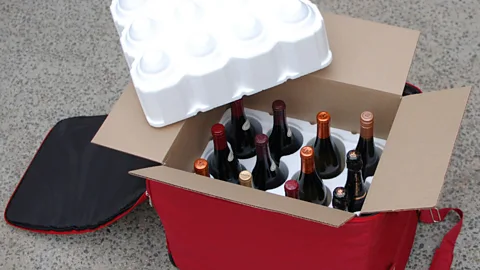How to transport wine home safely

When visiting vineyards you have a few options – some more DIY than others -- for bringing home the wine you buy on the road.
When you travel to visit vineyards, you’re bound to want to purchase some of the wine you’ve sampled -- which leads to the inevitable question: once I buy it, how do I get it home? You have a few options, some better than others.
Ship it home
Wineries will normally arrange for shipping, which is both easier and more economical than trying to do it yourself, though it still gets quite expensive when you start to cross borders and cover large distances. The main alternative to shipping from a winery is to use Mail Boxes Etc, which has locations in wine regions all over the world. The cost, though, is almost always higher than shipping directly from the winery.
For example, sending a case (12 bottles) from a winery within the EU, from Tuscany to London, costs about 40 euros, and in the US, shipping a case from California to the eastern coast costs about the same, between $40 and $60. That’s not a bad a deal, and occasionally US producers will offer free shipping domestically as a sales promotion.
If you want to ship internationally (outside of the EU), prices escalate significantly, and country-specific import/export rules and tariffs further complicate matters. For instance, getting a case of wine from New Zealand to the UK typically runs around 165 New Zealand dollars, and it could take eight weeks or more to make the trip. From New Zealand to the US the price goes up to 290 New Zealand dollars. If that’s more than you’re willing to pay, consider the alternatives below.
Buy it when you get home
Wineries are happy to share information about where their product is distributed. If their wine is available locally then it makes sense to pick it up at home and let someone else worry about getting it from point A to point B. Of course, you’ll be paying retail prices at home, which may be slightly more expensive that buying direct from the winery. If you frequent a friendly, service-oriented wine shop, take advantage of it. Sometimes, even when the shop doesn’t carry the specific wine you’re looking for, the shop can make a special order for you if it already deals with the wine’s distributor. You’ll probably have to order a case as opposed to a few bottles, but you won’t pay shipping fees.
Bring it with you in your checked luggage
It sounds risky, but with the proper precautions you can pull this off with little chance of breakage. If you have just a bottle or two, you can handle things the old-fashioned way – wrap the wine in your clothes – or use specially-designed packaging such as Wine Skin or Wine Mummy, which you can buy in advance or purchase at many wineries. If you take the first route, be sure to place the bottles in water-tight plastic bags and to pad them well. Bubble wrap is another wise precaution.
If you want to bring home a case, you can check it as a separate piece of luggage, but don’t check a standard cardboard case, which will have a hard time making the trip unscathed. You can pick up styrofoam wine-shipping containers at most wine-region locations of UPS Stores and Mail Boxes Etc, as well as at some wineries. A case of wine conveniently weighs in at just under the usual 50-pound limit for checked baggage (though that limit varies by airline), so at most you’ll only pay an extra-luggage charge. To make carrying the case less of a burden, you can use a collapsible Wine Check case, which comes with wheels.
